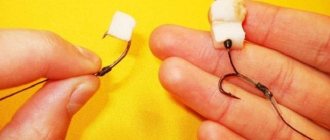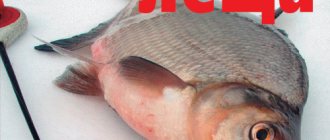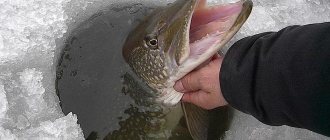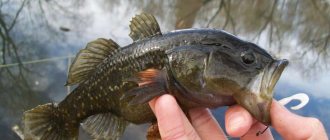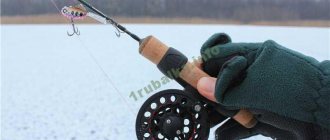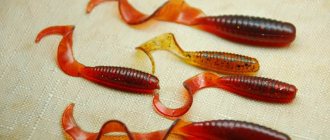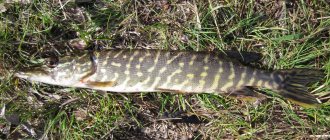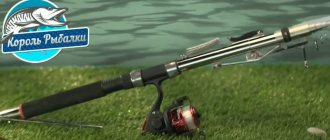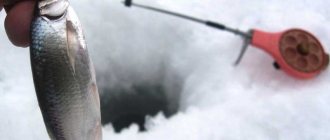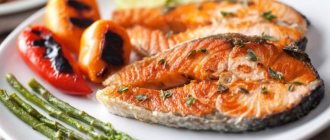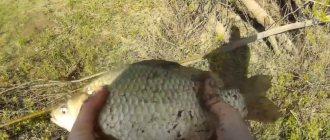The catch begins with perch, ends with salmon, trout and salmon on a spinning rod
Catching trout with a spinning rod, as well as other representatives of salmon fish, was considered a real success in the recent past.
Not so long ago, some 30-40 years ago, spinning was not yet as popular in Russia as this type of fishing is becoming today. Moreover, it was rare for anyone to catch this noble fish in this way. Nowadays, the chances of catching a large trout, salmon or other representative of this family are significantly increased. Now trout are caught mainly with spinning rods. Such fishing has also become widespread for other types of salmon: salmon, pink salmon, coho salmon, and Chinook salmon.
But, you can catch this noble fish on a feeder.
Trout
Where to fish
All salmon are caught only in very clean water. If the water is cloudy, mixed with vegetation, or brown and peaty, you don’t have to look for salmon there. Salmon live in fast rivers with many riffles and obstacles. Therefore, the best time to catch salmon is during high water, which helps the fish jump over river riffles. As the volume of water increases, the chances of a good catch increase significantly. The flood is fleeting, it is important not to miss this period.
The best time to catch salmon is early in the morning. Usually, before a rain or thunderstorm, the number of various insects increases significantly, and during this same period the salmon bite is greatest.
There are some features that are typical for such an exciting activity as fishing with a spinning rod for fish of the salmon family:
- Salmon almost never approach the shore; look for it near a fast stream.
- Remember the place where the bite was, next time it will bite there.
- Any salmon is a very cautious and timid fish. Approach the fishing spot as discreetly as possible and use camouflage clothing.
- The nozzle must be thrown very accurately.
- Salmon is an unpretentious fish; it can be caught using any spoon.
- To reduce the number of derailments, you need to carefully consider the equipment of the spinner, namely the location of the hooks.
Trout on a spinning rod
Trout fishing with spinning rods is carried out both on the fast-moving Far Eastern and northern rivers, and in the south of our country in the mountain rivers of the Caucasus. Moreover, in the south you can catch trout almost all year round.
But in northern rivers, trout fishing depends on seasonality. Trout differ in habitat - lake, brook, rainbow. The main feature of this species is that trout lives in cool water and its size is directly related to the amount of food in the reservoir. Little food means small fish. Since there is demand, a large number of paid reservoirs have appeared in which trout are bred intentionally.
Habitats
In general, the more inaccessible and snaggy the river, the more fish you can catch in it. Be prepared to have to wade through brush and brush upstream along the shoreline when hunting for trout. In such places you need to keep an eye on your spinning rod; it can be broken by slipping or catching on tree branches. In smaller rivers you are more likely to wade against the flow of the river. Your path will also not be easy, because getting over flooded trees and rock barriers in the river is not easy. But that's where the trout are caught.
You should look for trout during the day, in hot weather, where the water is cooler, in the shade of bushes, under snags. In pits and pools you can catch trophy specimens. Trout loves oxygen-rich water, and this is in those reservoirs with a rocky bottom and little vegetation. Also, water is enriched with oxygen at river rapids, which is why it lives there. The peculiarity of trout is that the greatest feeding occurs in the autumn, when the water gets colder.
Rod characteristics
When fishing for trout with a spinning rod in large rivers, you still need a long rod, 2.6-3 meters. This length of the rod is justified by the fact that trout is a cautious fish and does not come close to the shore. In order not to frighten it ahead of time, experienced fishermen even prepare their gear further from the intended fishing spot. If you fish in small and medium-sized rivers, and even wade, a length of 1.65 -2.1 meters will be enough.
Based on the test and action, it is preferable to choose a fast blank of medium hardness. After all, the most important thing is a sharp hook, and with a soft form this will not work.
Equipment
But pay more attention to the choice of fishing line or cord. It is better to buy a high-quality fishing line, even if it is a little more expensive, because the fish will desperately resist.
It would be a pity to lose a valuable trophy due to a broken fishing line. Typically, monofilament up to 0.2 mm thick is chosen for trout fishing. Braided cord, as it is more durable, can be thinner - 0.15 mm. The advantage of braided cord is that during a sharp hook it does not stretch, and the greatest contact between the bait and the rod is achieved. Braid also allows you to increase the casting distance. The equipment must include a long, half-meter leash.
You need to start casting from the coastal bushes. The principle of surprise comes into play here. Before the salmon bites you, you can catch a good specimen. The throw must be accurate.
Rotating spoons for trout
Trout on a spinning rod is a classic. A wide range of wobblers, spinners, poppers, and vibrotails are used as bait. All baits are selected depending on the fishing conditions and the reservoir. For catchability, flies or twisters are added to the spoon.
You can watch the video of how they are caught using wobblers:
Spinning spoons are the number one bait. Everyone knows Mepps spinners, catchy and almost win-win. For example, a spinner with red and yellow spots with copper petals. It can also be caught on spoons. You can see how this happens in the video:
Fishing with a spinning rod for trout will not seem like a trivial task to you, since the fish will resist when fishing, making various jerks and somersaults. If you hesitate to fish, the splashes will scare away other trout. The hook must be sharp and the retrieve must be quick.
Salmon on a spinning rod
The Queen of Salmons, that’s what this fish is called. Unlike trout, salmon is a much larger fish and does not enter small rivers. You can fish for salmon in large and medium-sized rivers with rapid currents in the North and East of the country. The presence of rocky rapids in the river are optimal conditions for salmon.
When fishing for salmon, it is important to choose the best fishing time. This time occurs when salmon enter the rivers, in mid-summer, late summer, early autumn - in September. As you can see, the period is ambiguous; it diverges significantly in time. You just need to know this period and remember that it does not coincide in different areas. But don’t think that fishing is only done in summer; salmon is caught all year round.
Salmon is caught on these rivers
Rod
The rod is 3 - 3.5 meters long, it can be shorter depending on the width of the river. Test 60-100 grams. It is better to fish with an inertia-free reel, but you can also use an inertial “meat grinder”. The braided cord should be strong enough, with a diameter of 0.25 mm.
Lures
There are no special secrets; the most common bait is a spoon. Since the fast current pulls the spoon to the surface, it is weighted with solder. Salmon is caught very well on narrow and long oscillating spoons made of copper or brass. You can also catch it with a spinner.
Salmon is a large fish, and the spinner chosen for it is also rather large. The length of the bait is about 70 mm, weight up to 50 grams. Kastmaster spinners performed very well. Color brilliant white, yellow, copper. They catch salmon and minou wobblers.
Since timber is floated down these fast-moving rivers, there are a lot of driftwood in them, and the lure clings to them, resulting in frequent snags. The river collects tribute from fishermen's lures. That is why the folk craft - homemade spoons for salmon fishing - is flourishing.
Salmon spoon
Salmon spinning fishing also involves the use of natural baits - a worm or shrimp. Although it is believed that in fresh water, Atlantic salmon, which comes from the sea, do not feed, but grab the bait only due to instinct.
Fishing
When fishing for salmon, it will fight to the last, such is the nature of salmon. You can watch the fight with salmon in the video:
A desperate struggle awaits you too. Some tips for catching salmon:
- If the salmon is going upstream, slacken the line and let the fish swim on. After a while it will stop.
- If salmon goes with the flow, you need to keep the line under tension and as soon as it lets go, tighten the reel. Your task is to reel in the line with the fish by any means.
- If the salmon is tired and stops against a log or rock, do not let it rest. After resting, he will go with the flow with renewed vigor. Throw a stone at the place where the salmon stopped to scare the fish away.
Popular sign: The sun is red in the evening - the fisherman has nothing to fear, the sun is red in the morning - the fisherman is not to his liking.
kakulov.ru
Where to fish
All salmon are caught only in very clean water. If the water is cloudy, mixed with vegetation, or brown and peaty, you don’t have to look for salmon there. Salmon live in fast rivers with many riffles and obstacles. Therefore, the best time to catch salmon is during high water, which helps the fish jump over river riffles. As the volume of water increases, the chances of a good catch increase significantly. The flood is fleeting, it is important not to miss this period.
The best time to catch salmon is early in the morning. Usually, before a rain or thunderstorm, the number of various insects increases significantly, and during this same period the salmon bite is greatest.
There are some features that are typical for such an exciting activity as fishing with a spinning rod for fish of the salmon family:
- Salmon almost never approach the shore; look for it near a fast stream.
- Remember the place where the bite was, next time it will bite there.
- Any salmon is a very cautious and timid fish. Approach the fishing spot as discreetly as possible and use camouflage clothing.
- The nozzle must be thrown very accurately.
- Salmon is an unpretentious fish; it can be caught using any spoon.
- To reduce the number of derailments, you need to carefully consider the equipment of the spinner, namely the location of the hooks.
Salmon fishing tackle
Spoons and other baits for salmon. As for the choice of bait for catching salmon with a spinning rod or other tackle, it was noticed that salmon prefer spinners and “Devons” of more natural and natural colors, such as brass, copper color or combinations thereof. Unnatural and exotic colors are considered deterrent colors, such as too bright (red, yellow, green, etc.) and polished. In this case, the shape and size of the bait does not play a big role.
If we talk about certain brands and types of spinners, then from my own experience I can note that in order to catch salmon on a spinning rod, you need to exclude from your arsenal spinners that, when reeling back, provide significant resistance, these are primarily spinners of the “Spinner” type and the like. There are also spinners that twist the cord, which also negatively affects the natural play of the bait; these are “Baikal” type spinners.
and spinners are not very effective, especially in the rivers of the North. But there are also good spinners, these are oscillating spinners, such as “Ural” and “Success”, they are ideal for all the criteria for catching salmon and have proven themselves in practice. The average generally accepted size of these spinners for catching salmon is 7-8 cm. They should also be equipped with one tee with a suitable size for the size of the spinner, but of good quality, here it is better not to save money and buy a more expensive tee, because there is nothing more offensive than a breakage of the spinner at the most crucial moment. Also, “Devons” are good for catching salmon. We choose their size the same as the oscillating spinners, and the colors can be more relaxed, i.e. it can be either one-color or two-color, there are also different combinations and patterns, but you should not joke with the colors and remember that they should not be too bright and exotic, this scares the fish.
I read somewhere that one guy has been successfully catching some pretty good salmon somewhere in the North with one lure for several years in a row. I haven’t tried to design it myself yet, I don’t get around to it, but I will definitely do it, and I’ll describe it to you, maybe some of you will want to have such a lucky spinner in your arsenal. So he writes that its length was about 70-80 mm, thickness 2 mm, and width 25 mm. This is a convex spoon, painted copper on the inside and bleached silver on the outside. We attach a tee to this spoon in the back part on the winding ring and our spoon is ready for use.
Salmon also takes well on fish-shaped baits; they are usually made of wood and filled with a small amount of lead to weigh them down. For coloring here you need to use warmer tones, such as yellow or white. You can also apply dark transverse or oblong stripes on top of the paint.
There is another good homemade spoon that I usually use to catch salmon during spawning. This is a triangular spinner, the material for the construction of which can be tin, brass, lead and some other non-ferrous metals. It is done very simply: we take a simple triangular file and bend it with a thin layer of one of the above metals so that the edge of the triangle is about 12-15 mm. Next, our triangle needs to be made heavier, this can be done by filling it with lead or an alloy of lead and tin, but the weight of the bait should not exceed g, it is best to use baits weighing 45-60 g. As for the length, the triangle should be 65-75 mm . On the front side we make a hole for the leash, and on the back side for the tee.
If you don’t have a suitable bait on hand, then you won’t find a bait better than a dead fish (usually herring). Just take this fish, hook it on the rig and off you go.
Equipment. You should also pay attention to the equipment of the spinners. The stiffer the equipment, i.e. The hook is rigidly attached directly to the spoon, so much the worse for you. The tee should play freely, so it is better to attach it to a separate strong wire 15-25 mm long. But we should not forget that salmon is a very strong fish, so the equipment and, in general, all the tackle must be very strong.
Rod. Cord (fishing line). Coil. As for the fishing rod, it must be durable and withstand a dead weight of 10-15 kg. The cord should be either braided No. 1-2, or solid - fishing line with a diameter of 0.6-0.8 mm. In the past, salmon fishing rods made from glued bamboo were used, but now there are many alternatives and stronger rods. Its length should be between 2.5-3.5 m. The reel should also not be cheap; its strength and especially reliability play a big role when fishing for salmon. It is necessary that the inner diameter of the reel allows about 125-150 m of fishing line to be laid on the drum.
Also, the rod should be heavy enough, which increases the strength of the butt and thereby excludes its middle and upper parts from participating in active fighting. If the cord is braided, then it is also necessary to cut off its tip after each successful and unsuccessful fight with salmon.
Without a doubt, just like the rod, cord and reel, other components of salmon fishing gear must be durable. I mean such elements as loops, leash, carabiner, tee and others.
Other fishing articles on the topic:
- Methods for storing salmon After catching salmon, it must be quickly, and most importantly, competently, cut and salted. This is done as follows. First, the fish is cut along the belly and all the insides are taken out, and the salmon is thoroughly washed from the middle. Further, closer to the head of the salmon, in...
- Spawning of salmon The spawning ground for salmon is a hole 2-3 m long, dug by the female. The famous ichthyologist Fritsch described the spawning process of salmon in the following lines: “The female salmon is located along her spawning ground, resting her head on the edge of the hole, and awaits the arrival ...
- Useful tips for catching salmon When pulling the line with a reel, you need to place the rod in such a position that the salmon seems to hook itself. Those. It is necessary that the rod and fishing line create an angle of no more than 150 (0 degrees ideally). When the salmon grabs the bait with its power, then the tee...
- Lures for trout fishing Now let's talk about baits. A wide variety of baits are used for trout fishing. In principle, trout can be caught with any spinning bait. Rotating lures should be considered the most versatile and convenient lures for trout fishing...
- Oscillating spoons for trout fishing Despite their lack of promotion, oscillating spoons are widely used in trout fishing, especially miniature oscillating spoons. In the picture on the left is the smallest caste master, which is only made by the company, and on the right is a homemade one...
- Tackle for catching carp The methods of catching carp are not very diverse, but quite the opposite - there is only one method (fishing with a fishing rod), but there are several gears for catching carp. Let's first consider what a fishing rod and its components should be like for carp hunting. Rod. ...
- Gear for catching carp Despite the fact that there is a lot of gear for catching carp, it is still mostly caught with a regular fly rod. Rods for catching carp must be strong, of medium action, and no shorter than 4 meters long. For fishing, carp is quite...
- Tackle for catching bream in summer Tackle for catching bream, it should be noted, you need to start with choosing a fishing rod. Carbon fiber rods of medium hardness and lengths from 5 to 9 meters have proven themselves well. It is not recommended to equip bream fishing gear with short...
- Trout Reel A trout reel must meet the following requirements. Firstly, it must have a fairly high gear ratio - no less than 1:5. For what? Very often, trout fishing is carried out in conditions where the bait goes downstream. If …
- Rotating spoons for trout fishing Rotating spoons for trout fishing should be as follows. Firstly, the spoon is used in sizes from No. 00 to No. 4 inclusive, and secondly, it must work well in the current. That is, if we move the spoon along the current and its blade is stable...
I would be glad if you share this article with your friends:
www.ruboman.ru
Rules for catching salmon on the Kola Peninsula
Salmon are caught only with licenses, and everything is serious here, this is not the Leningrad region, lined with nets up and down - the rivers are checked by mixed detachments of fish inspection and riot police with automatic weapons. I won’t retell the scary stories told by Murmansk residents about fisheries inspection and poachers, but they completely discourage them from engaging in unlicensed fishing.
The rules are quite simple (may vary for different rivers):
- It is prohibited to fish (to be on the river with gear) without a license
- The license is personal and is purchased directly at fishing sites at fish inspection points
- Fishing with a spinning rod or fly fishing is allowed under the license.
- In the case of a “catch and release” license, it is necessary to use barbless hooks, no more than double ones, and carefully release the fish, entering its parameters into the license
- In the case of a catch-and-seizure license, any hooks are used. It is prohibited to fish by trolling, trolling, or rafting from moving boats. You can fish from an anchored boat. The license allows the removal of one fish from a specific section of the river during a specific time period (from 4 to 6 hours, depending on the date).
- At the end of fishing, it is necessary to register the catch where the licenses were issued.
We purchased licenses of both types (“catch-and-seizure” and “catch-and-release”), for cosmic, even by St. Petersburg standards, money. As a result, we were never able to close all the “catch and seize” licenses, and we didn’t even get to the “catch and release” license.
This time we never met the legendary fish inspector with machine gunners, although our fellow travelers had dealt with it more than once on previous fishing trips. The meeting threatens with a harsh search of the entire camp and boats, checking of licenses, documents and gear, preventive threats and explanatory conversations - and this is even if everything is in order with your licenses.
If not, then it’s better not to meet the fisheries inspection. This place is harsh.
Spoons for catching salmon
Most fishermen, regardless of experience and nationality, consider salmon (Atlantic salmon) to be the king of fish. And, first of all, because of the difficulties that everyone faces who wants to catch salmon. The main difficulty lies in the physiological characteristics of this beautiful fish, since salmon practically does not eat in fresh water. That is why an angler who dreams of a trophy must offer the fish such bait that it will not be able to refuse. One of the best artificial baits that meets this requirement is a salmon spinner. Let's look at some of the most popular spinners, as well as alternative lures used to catch Atlantic salmon, both in the river and at sea. 1. Spoon spoon. Its weight can vary from fifteen to forty grams. It is served to the fish as follows: the cast is made downstream, at an angle, the bait is sunk and held in close proximity to the bottom. The color of the spoon directly depends on the degree of transparency of the water in the reservoir. A bait of a muted (copper) color will be appropriate in clear and clean water, while muddy and dirty water (for example, in high water) requires the use of spinners of provocative colors. 2. "Swedish iron". Probably, no spinner in the world can boast of more salmon biting on it than the Toby spinner, released by the Abu company. This oscillating spoon, produced for quite a long time, behaves exceptionally attractively (for salmon) both in a turbulent stream and in calm water. 3. Alternative baits: rotating spoons No. 3, No. 4, No. 5 (the choice of color is the same as described above); Scottish Devon, the peculiarity of its use is the mandatory use of a high-quality swivel that protects the fishing line from possible twisting; a fluorescent red-orange wobbler (no more than ten centimeters), which gives good results when catching salmon on the “track”.
In general, when fishing for salmon with a lure, don’t be afraid to experiment, because this fish is as desirable as it is unpredictable.
webchepetsk.ru
Eating
Benefits and harms
Salmon has been eaten for a long time. Scientists advise regularly including it in your diet because of its beneficial omega-3 fatty acids, which have a beneficial effect on the cardiovascular system. In addition, it contains phosphorus, potassium and the following vitamins:
- A,
- B12,
- D,
- H,
Do not forget about the large amount of protein, which is well absorbed by the human body. At the same time, it is a high-calorie food. Those who want to lose weight should eat it less often, and those who are allergic to red fish should avoid it completely. Individuals living in dirty water accumulate harmful substances and heavy metals in their bodies.
Preparation
Today, salmon is presented on store shelves in fresh, frozen and salted forms. Take a chilled product, as it preserves vitamins better
When choosing, pay attention to the color. An unnaturally bright color should scare away the buyer
He says that during cultivation, special bright dietary supplements were added to the feed.
You can prepare many dishes from salmon. The easiest way is to bake it in the oven. It is necessary to clean the fish and cut into pieces. Then the fish should be placed on a greased baking sheet and salted. Some housewives also sprinkle the meat with lemon juice. Baking time is no more than 20 minutes. Otherwise, the salmon can be overdried.
People who watch their weight steam salmon. They put the fish pieces into the steamer bowl. Then they salt the fish, sprinkle with lemon juice and sprinkle with dill. It is steamed for twenty minutes.
Sandwiches made from salmon and cream cheese are popular in Russia. Black bread should be cut into small pieces and greased with cream cheese. Some housewives prefer cottage cheese. Then pieces of lightly salted fillet and several sprigs of dill are placed on the cheese.
How to catch salmon
Fish and methods of catching it >> Salmon as a fish
The most favorable time for catching salmon is spring and autumn; it is at this time that the fish willingly go for spinning. It should be noted that in spring, in clear weather, the best time for fishing is morning and evening, but in cloudy weather, the bite usually occurs during the day. In autumn there are no such problems, and salmon can be easily caught at any time during daylight hours. In addition to spinning, you can also use fly fishing or a fishing rod using natural bait, for example, shrimp or worm.
A good bait for salmon is a small dead fish, for example, a herring, while the shape of the spoon is not particularly important; moreover, excessive brightness can even scare away a cautious predator. The equipment is important: the tougher it is, the worse it is. Thus, it is not recommended to attach the hook directly to the spoon; on the contrary, good results are obtained if you use a spoon with a tee, which is suspended on a separate tackle.
When choosing a place, it is worth considering that salmon prefer deep rivers with strong currents, the beds of which are littered with large stones that form rapids. If there is a fish in such a place, it will immediately rush to the spoon that comes into its field of vision, and the catch most often occurs on the first cast. On the other hand, if there is no bite, this does not mean that there are no fish here. You may still have to tease her by repeating casts with a deviation in one direction or another. By the way, when going after the queen salmon, it is worth remembering that, as a rule, a license is required to catch it, which should be taken care of in advance.
Fishing for salmon with a spinning rod
When choosing gear, you should remember that there is always a chance of catching large fish, therefore, the spinning rod must have sufficient power, although, of course, you need to take into account the characteristics of the reservoir where you are going fishing. In medium and large rivers, where catching salmon weighing more than 10 kg is quite possible, it is better to take a strong two-handed rod up to 2.5 meters long. It is also worth paying attention to the guide rings, which should have a larger diameter, which will make it easier to cast light spinners and eliminate the problems associated with the use of relatively thick fishing line.
If the fishing line is thin (about 0.3 mm), you can use open inertia-free reels, but when hunting for large fish, when using heavy spoons and thick fishing line, you need to take multiplier reels, and in any case, the supply of fishing line should not be less than 100 meters. The diameter of the latter depends on what exactly you are going to catch, and if your plans include river monsters weighing over 10 kg, a fishing line with a thickness of 0.45 mm is not the limit.
Any spinners are suitable; if desired, you can choose a rotating tackle or a wobbler. The only thing that is critical when choosing is that the spinner should be deployed as close to the bottom as possible, and the decisive factor is not the design and weight, but the compatibility of the latter with the speed of the current. It happens that in deep rivers even a 50-gram spoon is not enough. Sometimes the fact that light tackle is very difficult to throw over a long distance speaks in favor of greater weight.
It is advisable to have several spinners and start fishing with the lightest one, casting it across and slightly upstream. If results are not achieved, you need to gradually switch to heavier tackle, and if the current is strong, first without reeling for some time. Nobody will give you exact advice here, and you can only achieve what you want on an unfamiliar body of water through experience.
Usually the bite is felt as a sudden snag of the line, but if the fish takes the bait in the same direction as the spoon is moving, the bite is perceived as an additional heaviness. In any case, you need to hook sharply and strongly, and the intensity of the hook increases in proportion to the distance to the fish. After hooking, the salmon first freezes in place for a moment, then tries to free itself with tremendous force. Interestingly, not too large fish, weighing up to 5 kg, resist especially strongly. Larger specimens make periodic jerks, but then stop fighting for a while, apparently trying to choose a more advantageous position to use their powerful strength.
It is most difficult to fish for salmon in places with strong currents, when the pressure of the water flow is added to the movements of the fish. The most difficult option is when a large fish rushes downstream, and simply trying to hold it by force is not the best option - there is a high probability of the line breaking or slipping. It would be more correct to take into account the fact that stubborn salmon always tries to move in the direction opposite to the one in which the fishing line is pulling it. Therefore, it is better to let the fish “go” downstream, while you yourself move downstream from the bite site, and then start reeling again. At the same time, the salmon will go up, thereby making the task of catching it easier.
In any case, you shouldn’t force things; however, you shouldn’t hesitate either. When the fish leaves, you need to try to hold it without making excessive efforts, and if it stops, on the contrary, you need to increase your efforts. You should be especially careful during jumps, when the line tension needs to be loosened by tilting the rod forward, and then quickly raising it, thus compensating for the lost tension. When the fish moves smoothly, with virtually no resistance, you should constantly be ready, holding the rod vertically: salmon is a worthy opponent, and does not give up until the very end.
Fly fishing for salmon
As with spinning, the choice of rod and line depends on the fishing conditions and your personal experience. There is no consensus here; some anglers prefer relatively short one-handed and two-handed rods up to 3.5 meters long. Others fish with two-handed rods up to 5 m long, and sometimes more. Of course, a longer rod makes it possible to effectively explore difficult places in a reservoir, and it’s more reliable to fish for salmon this way. On the other hand, a short rod is less tiring and casting is much easier when fishing from the shore. In any case, it is worth taking care of the minimum weight of the gear.
The main requirement for a reel is reliability, which is why many fishermen use medium-sized inertial reels when fly fishing. In this case, the entire fly fishing line, as well as 100 meters (preferably even more) of extension line, can easily be placed on a drum with a diameter of 10-12 cm. The range of special salmon flies that are used when fishing for salmon is huge, and some of these masterpieces can without stretch be called works of art. However, many do not want to purchase ready-made ones and make their own flies. If you choose this path, there are a number of rules to keep in mind. Firstly, all individual elements of the gear when wet should not block each other’s movement. Secondly, the color palette of hairs is limited to only a few colors: black, green, blue and orange.
No one will say which fly to choose, but there are still some general principles, since, ultimately, everything depends on the weather and the condition of the water in the reservoir. At the beginning of the season, take larger flies, gradually reducing their size over time. In clear water, on a sunny day, the most catchy flies will be light ones, especially blue ones; when the sun is hidden by clouds or the water is not as clear as we would like, the fly should be contrasting, and the best color is orange.
There are several fishing tactics, the simplest is that the fly is allowed to swim freely downstream, and then with short jerks it is pulled up. This technique is good on small rivers with weak currents, but on more serious rivers they do things differently, casting almost across the current. In this way, it is possible to fish a much larger area, and it is especially important that when approaching the place where the salmon are supposed to stay, the fly is already at the required depth.
The bite, as when fishing with a spinning rod, is usually felt as a sudden hook. In this case, most often at the moment the fly is grabbed, the direction of movement of the fish coincides with the direction of its movement, after which the fish turns sharply, changing direction to the opposite. If you hook right at this moment, the hook, especially a single hook, will most likely simply fall out of the predator’s mouth. To avoid this, you need to pause for a while, giving the fish the opportunity to turn around unimpeded, and only then strike vigorously. After this, the hook will reliably stick into the fish’s mouth, which guarantees the success of its landing.
profi-troll.ru
rubaky.ru
Where and how to catch sea crucian carp
Sea crucian carp (weasel) lives in many seas of the World Ocean. This fish has 30 genera, which include 116 species, and belongs to the family of spar fish. Sea crucian carp has a characteristic common to all species - it is a tall, flattened, rounded body.
The dorsal fin has powerful spines, a well-developed lateral line, and excellently developed front teeth shaped like incisors or fangs.
This fish is quite common in subtropical and tropical waters, especially in the Atlantic Ocean.
Sea crucian fishing
is popular with many fishing enthusiasts. As a rule, sea bream lives in shelf coastal waters.
Sea crucian carp also lives in the waters of the Black Sea (4 species) and is less common in the Sea of Azov.
Sea crucian fishing
is significantly different from fishing for ordinary freshwater crucian carp, familiar to most anglers. This is due to very different habitats and living conditions. This also largely applies to the diet of these fish.
Laksir is not a very large fish, whose lifespan can last from 5 to 8 years. Its maximum size can reach 45 cm, and its weight is just over 2 kg. But on average, crucian carp is 18-20 cm long and weighs about 250 grams.
Small schools of this fish usually move actively if there are a lot of swimmers in the sea. The laksir moves away from the shore during the day and approaches it again at dusk. In those places where sea crucian carp are not too disturbed, they are excellently caught during daylight hours. If a light wind blows and there is slight roughness in the sea, the crucian carp bite improves.
Typically, sea crucian carp in the summer prefer to stay at depths of 1 to 10 meters. This fish is also found in deeper places, but mostly stays in shallow waters.
With the onset of November cold snaps and until the second half of April, in the Black and Azov Seas, fishing for sea crucian
from the shore is generally only incidental, and the capture of this fish is very rare. During cold periods, sea crucian carp migrate to quite significant depths, where they spend the winter.
But when fishing from a boat, sea crucian carp can be found even in winter. Usually this fish can be found on coastal dumps that go sharply to a depth not far from the shore, as well as on underwater hills with a depth of 25-30 meters on average.
Tackle
To catch sea crucian carp in the Black Sea, you can choose various types of fishing rods suitable for fishing in the sea. Some fans prefer jig fishing. Others use tubular models that have a hollow tip. This is a matter of taste and preference.
However, the most effective sea crucian fishing in the Black Sea is
occurs using the jig method. Bottom and bottom wiring using silicone baits encourages this fish to actively bite.
But in the Mediterranean Sea, using microwobblers, sea crucian carp can be caught as the main prey.
Sea crucian carp is caught very well on small spoons. Small and compact models of spoons work well with edible rubber bait, and with a high concentration of fish and their activity, even without bait.
A wide variety of wiring is used: slow bottom wiring, dragging along the bottom, jerking, tossing. In a word, everything depends on the imagination of the fisherman himself.
As was said earlier, the best bite for sea crucian carp occurs if the sea is slightly rough. But in calm conditions this fish refuses to bite and begins to become active when a small wave appears. Sea crucian carp begin to bite very actively after a storm.
While the water in the sea is in a disturbed state. At this moment, large individuals weighing 0.5 kg, and sometimes up to 1 kg, begin to peck. Also, the sea crucian bite becomes active several days before the storm begins.
At that moment, when the sea has already begun to be rough and a decent breeze is blowing.
In the second half of summer, sea crucian activity peaks. At the end of June, it comes quite close to the shore and begins to actively feed. This excellent bite continues throughout August and September. But when cold air masses arrive, the weasel goes to great depths and fishing for it from the shore practically stops until the next season.
Bait
You can catch shrimp right near the shore or piers, having a net with a small mesh. It won't be difficult to find mussels either. These mollusks are usually attached to the walls of underwater elements of breakwaters, piers, or to stones. But before baiting, the shells should be split and clean shellfish meat should be placed on the hook.
Rating of the top 5 spinning rods for salmon and pike
- Daiwa Exceler-AR - (4000 RUR)
- MIKADO NIHONTO MH TELESPIN 240 — (2500 RUR)
- Black Hole Classic 270 — (7500 RUR)
- St. Croix AVID - (6000 RUR)
- Major Craft RIZER - (RUR 13,000)
We will call the St. spinning rod optimal in terms of price/quality ratio. Croix AVID, its main parameters: 2-4 lb., 1/32-3/16 oz., fast action. It is especially suitable for jigging; for twitching it is better to choose shorter spinning rods.
The rod should be designed to handle lures weighing between 10 and 40g and have the strength to handle a 10kg redfish.
Choose a powerful spinning or multiplier reel.
The spinning spool must be at least 3000 in size, since a lot of fishing line must be held, the volume of the spool must be appropriate, with a diameter of 0.30.
Also, the reel must be equipped with a reliable drag to quickly respond to fish jerks. In general, a cheap reel is not suitable for large salmon, as it will break very quickly, choose models from Daiwa, Shimano, Ryoby, from the middle price segment, believe me, a high-quality reel will be more profitable in the long run.
Example of reels: Ryobi Excia MX, Daiwa Revros MX, Daiwa Exist, Shimano Elf, Shimano Twin Power.
You should also grab a few skeins of fishing line or braid. The diameter of monofilament is 0.28-0.35 mm, braided line is 0.12-0.22 mm.
But braided fishing line should only be used in combination with a flexible fishing rod, which will reduce the possibility of slips. It is preferable to use monofilament, although the performance of wobblers will be better on braid.
Salmon is an extremely strong fish. It is worth taking care of a sufficient supply of fishing line, because this fish is capable of making throws of 50-70 m.
Therefore, the optimal length of line on a reel is approximately 150 m.
Before you start fishing, you should once again check all fasteners and carabiners, rings and tees.
Where do they catch salmon?
Salmon belong to the category of migratory fish that live in the sea or lakes, and rise into rivers only for the purpose of reproduction.
In most cases, after reaching 4-6 years of age, all salmon species enter very fast rivers with rapids and often rise upstream for several hundred kilometers.
The periods of entry of salmon into rivers are not the same: salmon of the so-called “spring” form enter in the summer and early autumn before spawning, while adherents of the “winter” form enter either in late autumn or early spring, and stay there until spawning on average for about a year .
As a stopover in rivers during the period before spawning, salmon choose small, fast places in reservoirs with a rocky or sandy-pebble bottom surface.
When to catch salmon
Experience shows that the best natural conditions for trolling salmon are cloudy weather and the presence of a small wave.
Fishing will be especially productive in early spring or at the beginning of the summer season. At this time, specimens of different weights come across - from 4 to 20 kg. From the second half of June until the beginning of November, salmon are caught in rivers more often than in lakes.
Salmon spawn mainly at water temperatures of no more than 6-7 degrees. These are, first of all, indicators for the period from the second half of September to mid-November.
For spawning, salmon prefer running waters, and for feeding purposes, they choose areas of calm water where there is enough food.
Young individuals feed mainly on various insects and small aquatic invertebrates, while adult salmon also do not refuse crustaceans and small fish.
Trout and salmon rods. The agony of choice and testing at the Greenvald paid reservoir.
About 20 years ago, many Russian spinning anglers’ acquaintance with decent tackle began with the so-called “steelheads” of American origin. What did they do with them! They were jigging and throwing small wobblers. But something similar to the original purpose (such as fishing with a spoon in the current) was done with them extremely rarely. It was then that we became acquainted with spinning rods from Gary Loomis, produced under the G.Loomis brand. Mass acquaintance with bass tackle, which largely shaped the current standard, occurred much later among our public. And these were mainly Japanese spinning rods.
At the moment, domestic tastes and preferences have already taken shape. We use steelhead and other salmon and trout rods for their intended purpose. That is, we catch salmon on the Kola, taimen and lenka in Siberia, brook trout and brown trout in the small rivers of the Russian north. And Gary Loomis is now creating under his new brands North Fork Composites and EDGE.
The distinctive feature of American salmon rods is not even the action. A softened system is a side effect of completing the main task. And in short, it looks like this - the rod should hold back the pressure of any monstrous predator. And especially since this pressure is multiplied by the help of a strong current and the excellent strength of the fish itself. Therefore, most of the rods discussed have a regular action and an impressive margin of safety. Thinwall and American steelhead are incompatible. Sometimes you can see the inscription fast on a similar rod (for example, EDGE STR865-2IM). But don’t kid yourself, this fast is a salmon fast that has nothing in common with bass pegs. The increased rigidity of this rod is designed to diversify the angler’s technical arsenal. In addition to uniform wiring with this spinning rod, you can also depict elements of manual animation of the bait.
Long light test rods are a different story. For example, STR862-2IM. Length 259 cm, stated test - up to 10 and a half grams. Sometimes they say that the level of a manufacturer should be judged by long lites. Because making a long fishing rod both functional and reliable is not very easy. ST 862-2 IM falls into this long-light category. Both the decal and the NFC catalog say "slow". This term is easier to describe spinning for the understanding of our public, but this description, again, will not be exhaustive. Ideologically, the form is very close to those described above, i.e. relatively soft “on vibrations” and with residual vibrations, but not at all slow in static conditions. On the wiring of small persistent wobblers, the bending shape is closer to fast. Loading of the butt is felt only by hand, and mainly by twitching; visually, the dip in the butt is not visible at all. In terms of its intended purpose, I would describe the spinning rod as a river all-rounder, without a strict connection to specific baits. The versatility of the spinning rod makes it quite comfortable to fish with small wobblers, including soft twitching, and with spinners and spinners.
Well, another subspecies of the rods described are light short rods from the Fresh Water series. In our understanding, this is the American version of trout stream (or, if you prefer, brook) rods. Americans themselves understand this category somewhat more broadly. In addition to trout, they include all relatively small predators that live in American rivers and streams as the target audience for this series. And they also have fewer prejudices about fishing methods. It doesn’t bite on a spoon, which means there is nothing stopping you from switching to fishing with caviar, dead fish, flies and any other bait that is not prohibited by local rules. Therefore, the priority is not narrow focus on a specific type of fishing, but work on fishing and sensitivity when biting. The result is very versatile, reliable, I would even say, “tenacious” instruments.
Most of the FW series spinning rods, however, feel “on the shakes” and are reminiscent of Japanese rods of a similar specialization. With one exception - they are a little tougher. But this “a little tougher” in the conditions of real work with bait and real fishing leads to the fact that their comfortable test range for baits is significantly wider. And when playing, they work more “stuffy” and more reliably, i.e. do not provoke the owner to delay fishing for the sake of safety of the tackle. In the video - work on fishing the FWR602-2IM spinning rod:
The described type includes all rods of the FW series, except for the 664th model. Now she’s already showing off the “American” in herself. The power reserve is felt immediately. In practice, this means that with light tackle in a fast current you can manually animate fairly large baits, such as the well-known L-Minnow 66 wobbler.
Another exception to the rule appeared just a few months ago. Since in the described fishing conditions the main priorities are reliability and balance of all characteristics, the FW series rods have always been made only from medium (according to the Lumisov version) IM grade graphite. At the request of a Japanese dealer, a long (7'4″) ultra-light was made for the first time from top-end HM graphite. Thus, a new form FW741-2HM appeared, formally fitting into the internal Japanese canon, but with all the ensuing consequences of the American pedigree. That is, despite its apparent lightness and subtlety, it is a powerful and reliable tool. In the video, catching a pike from the kilo+ category with a jet spinning rod FWR741-2HM:
An essential aspect when choosing spinning rods of this kind is the difficulty of comparing rods of completely different origins in a store environment. For obvious reasons, even if a store is ready to issue a stick for testing, it is almost impossible to quickly get acquainted with its operation in real conditions. Most suitable rivers are too far from the metropolis. Therefore, we came up with a fairly obvious solution - to invite interested salmon fishermen to test gear at the Greenvald trout fishery, located in the Leningrad region near Zelenogorsk. There are suitable fish there, and testing can take place in conditions that are really close to “combat” (with the exception, of course, of fast river currents). So we invite everyone interested in gear from Gary Loomis (and just the curious) to Greenvald, on Saturday, June 17th.
Salmon fishing with spinning rod
In spinning fishing, the selection of the optimal bait is of great importance. This predator needs baits that will provoke the fish to attack the same lure quickly and decisively. To do this, it is important to ensure such a visual effect and vibration that will be as similar as possible to the movements of the usual salmon prey.
It is worth considering that salmon very rarely react to movement that is too fast and passing in the distance, while baits moving slowly near the bottom are very attractive to this predator.
Where do salmon (lake salmon) live?
Salmon is a diadromous fish that is born in fresh water. As a result of age-related mutations, it moves to salty bodies of water, where it lives for almost the rest of its life. Therefore, its habitat is very wide. Atlantic salmon is found both in the waters of the North Atlantic and in the Arctic Ocean, freshwater bodies of the Scandinavian Peninsula and Finland. On the territory of the Russian Federation, salmon lives in lakes and rivers of the Kola Peninsula and Karelia, the waters of the Baltic and White Seas, and in Lakes Onega and Ladoga.
Spinner for salmon
Most often, when fishing for salmon, oscillating spoons of large weight and length are used, the performance of which directly depends on the strength of the current, width and depth of the reservoir.
It is generally accepted that a salmon lure should touch the bottom the first time it is cast across the current. The angle of the fishing line in relation to the bottom is approximately 45 degrees.
In such conditions, the wiring will be attractive to the predator, and the chance of snags will decrease.
We have compiled a short list of the most catchy lures for salmon. Much attention was paid to salmon spinners from the Kuusamo company, which showed their high efficiency in catching salmon, pink salmon, taimen, grayling, trout and even pike. Naturally, these spoons can easily catch other types of fish, but time has shown that their calling is salmon fishing .
